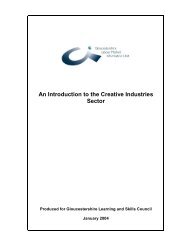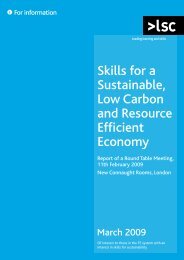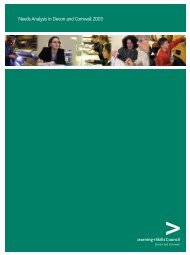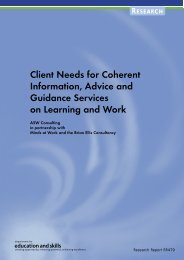Mapping the Big Green Challenge - The Skills & Learning ...
Mapping the Big Green Challenge - The Skills & Learning ...
Mapping the Big Green Challenge - The Skills & Learning ...
You also want an ePaper? Increase the reach of your titles
YUMPU automatically turns print PDFs into web optimized ePapers that Google loves.
26 Chapter 3 - <strong>Mapping</strong> <strong>the</strong> <strong>Challenge</strong>rsChart 6 – <strong>Challenge</strong>r group origin compared with formality (legal status)Unconstituted group5931Constituted group5016Bottom upPartnershipTop downRegistered company4919Charity705470% 10% 20% 30% 40% 50% 60% 70% 80% 90% 100%<strong>The</strong> origin of a group influences <strong>the</strong> amount of independence it has in its own decision making, and<strong>the</strong> groups of top down origin are less likely to have full autonomy, many being constrained by <strong>the</strong>policies of <strong>the</strong>ir parent organisation. Constrained independents are groups that voluntarily affiliate<strong>the</strong>mselves to ano<strong>the</strong>r organisation, such as a local environmental group deciding to identify<strong>the</strong>mselves with <strong>the</strong> Friends of <strong>the</strong> Earth network. In doing so, <strong>the</strong>y gain an identity and supportfrom <strong>the</strong> parent organisation, but <strong>the</strong> group itself makes decisions about its activities and methodsof working, within <strong>the</strong> constraints imposed by <strong>the</strong> parent organisation. Autonomous sub-groups aregroups formed within a community organisation (such as a faith group) but which are not affiliatedto <strong>the</strong> parent. <strong>The</strong>y retain an identity inherited from <strong>the</strong> parent body. Dependent sub-groupsinclude branches of organisations set up by national bodies, which take <strong>the</strong>ir direction and activitiesfrom <strong>the</strong>ir parent group, and core grant funded bodies dependent on a parent organisation forcontinued support.Chart 7 – Group autonomy, 315 proposalsDependent subgroup7%Partnership6%Autonomous subgroup3%Constrainedindependent20%Independent64%AutonomyNo. ofProposalsIndependent 202Constrained63independentAutonomous sub-group 9Dependent sub-group 21Partnership 20Total 315Appleby Ltd July 2009











